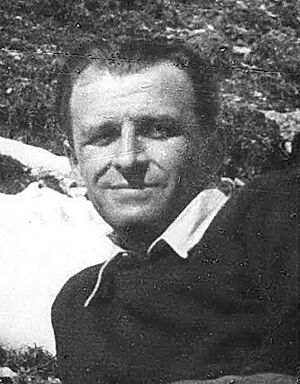Gerard Antoni Ciołek facts for kids
Gerard Ciołek (born September 24, 1909 – died February 15, 1966) was a famous Polish architect. He was also a top historian who studied and designed parks and gardens.
Contents
Early Life and Education
Gerard Antoni Ciołek was born in a small town called Wyżnica. This town was part of the Austro-Hungarian Empire, in a region known as the Duchy of Bukovina. Today, this area is in Ukraine. His parents, Adolf and Ludwika Ciołek, came from nearby regions. His father worked as a high-ranking official in the Austrian Tax Office.
After World War I ended, the Austro-Hungarian Empire broke apart. Wyżnica became part of Romania. In 1921, the Ciołek family moved to the new Republic of Poland. They settled in the southern city of Lublin.
Studying Architecture
In 1929, Gerard Ciołek finished high school in Lublin. He then moved to Warsaw, the capital city, to continue his studies. At first, he wanted to study drawing and painting. He was especially interested in painting outdoors, known as "en plein air" watercolours.
However, he later decided to study architecture. He enrolled at the Warsaw University of Technology (Politechnika Warszawska).
Research and Interests
In the mid-1930s, Ciołek worked as a research assistant. He helped Professor Oskar Sosnowski at the Warsaw University of Technology. During this time, he learned a lot about Polish folk architecture. He also studied how to protect old buildings and historical sites.
Around 1937, he became very interested in the history and design of parks and gardens. He also cared about how towns were planned. He wanted to make sure human settlements fit well with nature.
In June 1939, he married Regina Najder. Her family included aristocrats, landowners, engineers, and doctors from Kiev and Ukraine.
World War II and Resistance
When World War II began in September 1939, Ciołek joined the Polish Army. He served as a Second Lieutenant in an air-defense unit in Wilno.
Between 1940 and 1944, Nazi Germany and the Soviet Union occupied Poland. During this time, Ciołek lived in German-held Warsaw. He joined the Armia Krajowa, also known as the "Polish Home Army." This was a secret resistance group. He used the code name "Biała," which was his family's battle-cry.
Underground Education and Research
Ciołek also taught architecture and town planning secretly. He lectured at the underground Warsaw University of Technology, which was banned by the occupiers. In early 1944, he earned his Ph.D.. His research was about how the environment affected village shapes and folk architecture in Poland, Belarus, and Ukraine.
In August and September 1944, he took part in the Warsaw Uprising. This was a major fight against the German occupation. He was in charge of defending the Krasiński Library building. He also fought in the battle for the German SS-held PAST skyscraper.
After the uprising was defeated, he was held in prisoner-of-war camps. These camps were in Pomerania and near Lübeck in northern Germany.
Return to Poland
After World War II ended in Europe, Ciołek served briefly with the 1st Independent Parachute Brigade in Germany. He returned to Poland in December 1945. He was reunited with his wife and son, Krzysztof Oskar Ciołek (1940–1953), in Olsztyn.
Post-War Career and Achievements
The family soon moved back to Warsaw. From 1946 until his death in 1966, Ciołek taught at the Institute of Architecture at the Warsaw University of Technology. Starting in 1948, he also became a professor. He taught Urban Planning and Landscape Design at the Cracow University of Technology (Politechnika Krakowska).
In the early 1950s, he helped design a tourist lodge in the Tatra Mountains. This lodge, called 'Schronisko Górskie PTTK w Dolinie Pięciu Stawów Polskich,' opened in 1954.
Restoring Historical Parks
Over 20 years, Ciołek taught many students in Kraków and Warsaw. He also guided about fourteen students through their Doctoral studies. He worked on restoring over 100 historical parks across Poland. These included famous places like Arkadia, Baranów Sandomierski, Krasiczyn, Lubartów, Nieborów, Rogalin, and the Royal Park in Wilanów.
He was also a member of the State Council for Nature Conservation. He served on the boards of the Tatra National Park and the Pieniny National Park. He wrote more than 60 research papers and books.
Major Works and Recognition
His important book, Ogrody Polskie (Gardens of Poland), was published in 1954. In 1958, Ciołek received a special award. He was given the Knight's Cross of the Order of Polonia Restituta. This is a high honor in Poland.
In 1965, he started two very large projects. One was a history of monastic architecture in Poland over 1,000 years. The other was an encyclopedia of gardens and garden design from all over the world.
However, he passed away the next year, at age 56. He died while skiing in the Tatra Mountains. He was not able to finish his final works. His unfinished research is kept in archives as the Teki Ciołka (Ciołek files).
Selected Publications
- Ciołek, Gerard. 1954. Ogrody polskie. T. 1, Przemiany treści i formy (Gardens of Poland. Vol. 1, Changes in content and form). Warsaw: Budownictwo i Architektura.
- Ciołek, Gerard. 1955. Zarys historii kompozycji ogrodowej w Polsce (An outline of the history of garden and park design in Poland). Łódz-Warsaw: Panstwowe Wydawawnictwo Naukowe.
- Ciołek, Gerard. 1964. Zarys ochrony i kształtowania krajobrazu (An outline of principles of landscape formation and conservation). Warsaw: Arkady.
Posthumous Publications
- Ciołek, Gerard. 1978. Ogrody polskie. A revised and expanded edition of his 1954 book, updated by Janusz Bogdanowski.
- Ciołek, Gerard. 1984. Regionalizm w budownictwie wiejskim w Polsce (Regionalism in Polish folk architecture). Kraków: Politechnika Krakowska. This was his Doctoral dissertation from 1944.
See also
- See also, in Polish Wikipedia, a parallel though not identical entry Gerard Ciołek.
- See also, via an external link, the complete bibliography of Gerard Ciołek's publications.


